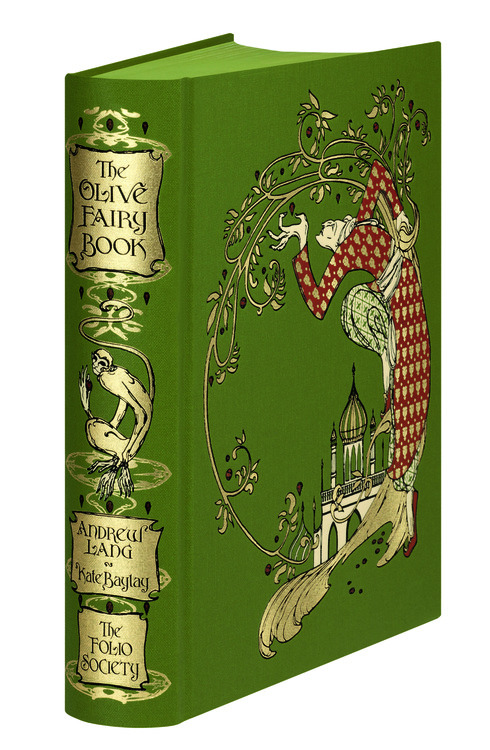The Olive Fairy Book
"The Olive Fairy Book," by Andrew Lang, illustrated by Kate Baylay; The Folio Society, $84.95, 296 pages.
In late January, author Jane Yolen - considered by many to be the 'Hans Christian Andersen' of her generation - spoke with me about the introduction she wrote to theFolio Society's The Olive Fairy Book, a new edition of fairy tales originally published in 1907 by Scottish author Andrew Lang. We also talked about heroes, magic, and discovering hope through storytelling.
THE OLIVE FAIRY BOOK Reproduced by permission of the publisher, The Folio Society, London.
The Folio Society & Andrew Lang
There are twelve Fairy books, and the Olive Fairy is the eleventh in the series. As a child Yolen read many, if not all, of the Rainbow Fairy series. In the introduction to the Folio Society's edition she highlights three of her favorite stories- 'Jackal or Tiger,' 'Samba the Coward,' and 'Kupti and Imani.'
"I'm pretty sure I read them all as a child. I was one of those childhood readers who, once I found something that I loved, I would seek out everything that was related to it." The Olive Fairy Book includes all the elements necessary for riveting reading - heroic princes, wise fairies, talking animals, evil trolls, and witches. While being a prolific writer of children's novels and poetry, Lang was recognized as a leading authority on world folklore and mythology.
Bound elegantly in olive green cloth, this edition of The Olive Fairy is itself a work of art, featuring an Art Deco frontispiece and bright gold illustrations by British artist Kate Baylay. Inside, readers will find more visual feasts- twelve full-color illustrations and thirteen black and white drawings.
Yolen discussed the era that inspired the artwork, and why it is wholly appropriate for this edition. "This book was published originally in 1907, which is when arts and crafts, art nouveau and art deco all come together."
Yet as beautiful as these pictures are, this edition is perhaps most appropriate for older readers. "I think the pictures in this book are exquisite. But they're also not for children. They're very sexy, very dark; some are quite violent. It's exquisite bookmaking and of course the Folio Society is known for that. And the price reflects that; it's for collectors. You can get the edition in paperback for very little money, but the point of this kind of book is that it's an art object." If a collector wishes to acquire the entireRainbow Fairy series, The Folio Society is issuing all twelve of the books, each similarly designed and illustrated by a contemporary artist. The Olive Fairy Book is the tenth to be published.

THE OLIVE FAIRY BOOK Copyright © 2013 by Kate Baylay. Reproduced by permission of the publisher, The Folio Society, London.
At least once a summer for the past twenty years Yolen has visited the gravesite of Andrew Lang in St. Andrews, Scotland, partly because his work played a significant role in her development as a writer. "He was one of the most important ones [to me.] And I happen to have a house there. When writers visit, I'll take them to the grave. Or if I'm on my own I'll go. It isn't that I'm genuflecting at his grave, it just happens to be a lovely grave with a beautiful Celtic cross on it."
In a classic example of serendipity, Yolen was unaware of the writer's presence in the town before settling there with her late husband, David Stemple. "I didn't even know about the connection when I first moved there. My husband was a professor of computer science, and took his second sabbatical at St. Andrews." (Now she spends her summers there, and returns to her home in western Massachusetts each winter.) After some poking around, Yolen found a chapel with a plaque dedicated to Andrew Lang. "I discovered that Lang was buried on the cathedral grounds. It was a hunt."
In November 2012, Yolen was the 22nd person and the first woman to deliver the annual Andrew Lang Lecture at the university, which was also celebrating the centennial of Lang's death. "Every academic in Cambridge has lectured here. The month after I was born, in March 1939, an Oxford professor named J.R.R Tolkien gave the lecture, which became the iconic essay on fairy stories - and really changed my life as a writer. So St. Andrews asked me, and I said, 'How can I follow in these footsteps?' As I said to the audience, 'Here I am, walking in Tolkien's shoes, who walked in Lang's shoes -- why not give me a ring and point me towards Modor?'"
To continue reading about The Olive Fairy Book, read my full review at Literary Features Syndicate!















